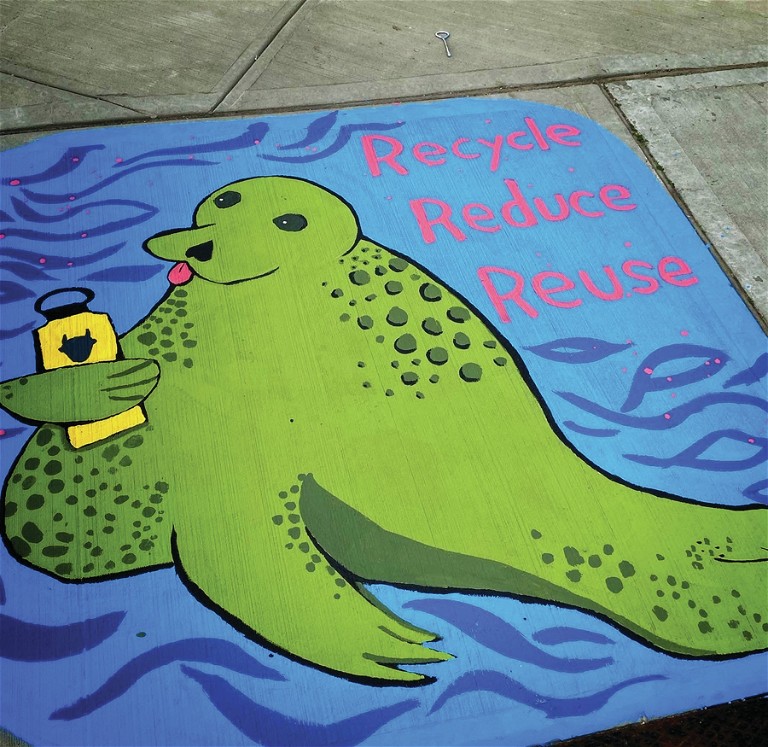HIGH SCHOOL
Collaborative storm drain mural painted with water-resistant, eco-friendly paint.
Tim Needles
Art is an amazing tool for communication, and when the message and images are well-designed, it can have a lasting impact. This is the goal of an environmental art project we developed at my school to help bridge classroom learning with the school district and larger community. Our storm drain painting project has expanded beyond the school walls, educating the community about water conservation and sustainability.
Starting with In-School Projects
The project began as a simple in-class poster design, and after researching information on the intersection of environmental action and art, it evolved into a larger in-school mural project. Nonprofit organizations such as National Geographic, Bow Seat Ocean Awareness Programs, Take Action Global, and the Wyland Foundation provided a wealth of data to share as well as competitions to enter, which motivated students.
Collaborative storm drain mural painted with water-resistant, eco-friendly paint.
The results were extremely positive and had a significant impact on the school, so we began working with the science department to extend the project further into the community. We collaborated with our district’s green team to add events like beach cleanups, sidewalk chalk advocacy, and tree plantings where students and community members could use their art to promote taking action locally to support the cause.
Storm Drain Painting Project
The ambitious next step was to design and execute paintings around the storm drains that collect rainwater in our community. We started with storm drains at various school buildings, and the work has since evolved into a legacy project, with new paintings being created throughout the community each year.
The approval process for the storm drain paintings was initially arduous, requiring input from the school district administration, local government, and the environmental protection agency, but it was a great teachable moment because students were involved in every step of the process.
Our storm drain project has expanded beyond the school walls, educating the community about water conservation and sustainability.
We began the project by working with the science department to learn about the issues related to our waterways and how reducing waste and pollutants helps to maintain our drinking water and supports the local ecosystem. We then discussed the United Nations Global Sustainable Development Goals and learned about the connections our local environmental issues have with the larger world.
Brainstorming and Feedback
This is when we turned to design and considered how we could create artworks that communicated these important messages with others in the school and community. We brainstormed and sketched out ideas, then solicited feedback from students and teachers throughout the school to ensure that the messages were clear. After receiving feedback, students designed posters to display throughout the school, and we began collaborating on a final single design to be painted around one of the storm drains in our community.

A sidewalk painting created during a community event.
Making Adjustments
Once the design was approved, we experimented with altering it to fit our limited palette; the paint is the same four colors you find on the roadway and was provided by the transportation department. We worked with a local artist to adapt the design to the eco-friendly paint, and then set a date.
Sharing the Experience
On the day of the event, local press arrived to help document the process. Students, educators, and community members all joined in on the fun with a sidewalk chalk drawing activity led by students.
Painting the storm drain with the water-resistant paint took about five hours. The next step was to celebrate the work and organize the documentation to share the experience with other schools around the world.
Students will inherit the planet, so maintaining the environment for the future is a concept that is close to their hearts. This project was an enormous success, both creatively and for the school and community because it allowed students to share their learning as well as their art.
NATIONAL STANDARD
Presenting: Develop and refine artistic techniques and work for presentation.
Tim Needles is an art instructional specialist at Smithtown High School in Smithtown, New York, and an adjunct at local colleges and universities. needlesart@aol.com The Power of Environmental Art